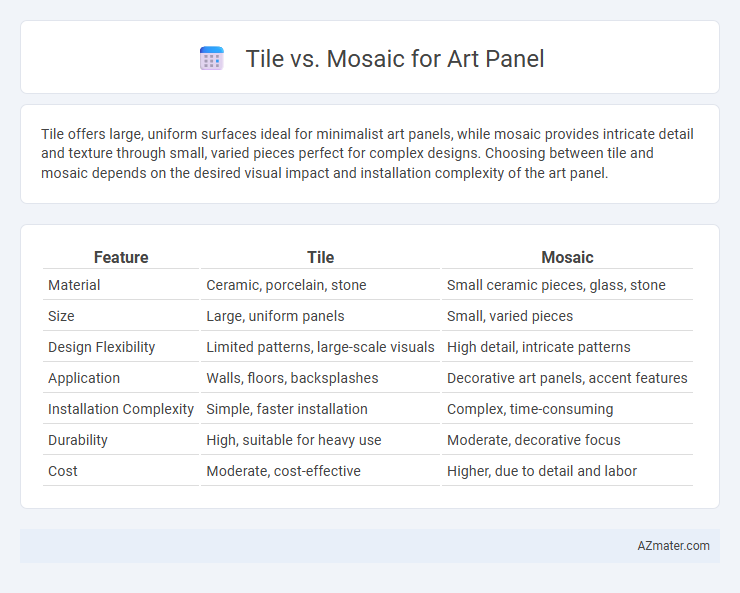Tile offers large, uniform surfaces ideal for minimalist art panels, while mosaic provides intricate detail and texture through small, varied pieces perfect for complex designs. Choosing between tile and mosaic depends on the desired visual impact and installation complexity of the art panel.
Table of Comparison
| Feature | Tile | Mosaic |
|---|---|---|
| Material | Ceramic, porcelain, stone | Small ceramic pieces, glass, stone |
| Size | Large, uniform panels | Small, varied pieces |
| Design Flexibility | Limited patterns, large-scale visuals | High detail, intricate patterns |
| Application | Walls, floors, backsplashes | Decorative art panels, accent features |
| Installation Complexity | Simple, faster installation | Complex, time-consuming |
| Durability | High, suitable for heavy use | Moderate, decorative focus |
| Cost | Moderate, cost-effective | Higher, due to detail and labor |
Understanding Tile and Mosaic Art Panels
Tile art panels consist of uniformly shaped ceramic or porcelain pieces arranged in repetitive patterns, providing durability and ease of installation for large-scale decorative surfaces. Mosaic art panels feature small, irregularly shaped pieces of glass, stone, or ceramic, creating intricate, detailed images with vibrant color variations that enhance visual texture. Both techniques offer unique aesthetic and functional qualities, with tile panels emphasizing consistency and mosaics highlighting artistic complexity.
Key Differences Between Tile and Mosaic Art
Tile art consists of larger, uniform pieces often used for flooring and walls, emphasizing durability and ease of installation. Mosaic art features smaller, varied pieces arranged to create intricate patterns or images, highlighting artistic detail and customization. The key difference lies in scale and complexity, with tile offering structural functionality and mosaic providing elaborate visual expression.
Materials Used in Tile vs Mosaic Panels
Tile panels commonly utilize ceramic, porcelain, or natural stone materials, offering durability and a broad range of colors and textures suitable for contemporary art displays. Mosaic panels, on the other hand, are composed of small pieces of glass, stone, or ceramic called tesserae, enabling intricate designs and detailed artistry with varied shapes and finishes. The choice between tile and mosaic materials impacts the visual complexity, texture, and overall aesthetic of the art panel, with tiles favoring uniformity and mosaics highlighting meticulous craftsmanship.
Design Flexibility: Tile vs Mosaic
Tiles offer greater design flexibility for art panels due to their larger size and uniform shape, enabling the creation of bold patterns and expansive surfaces with fewer grout lines. Mosaics provide intricate detail and a wider range of color variations by using small, individual pieces, allowing for complex, highly detailed imagery and texture. Choosing between tile and mosaic depends on the desired level of detail and the scale of the artistic design.
Aesthetic Appeal and Visual Impact
Tiles offer a clean, uniform aesthetic that provides a polished and structured visual impact for art panels, emphasizing large-scale patterns and bold color blocks. Mosaics create intricate, detailed imagery through numerous small pieces, resulting in a textured, dynamic surface with vibrant depth and complexity. The choice between tile and mosaic art panels significantly influences the overall artistic expression, with tiles favoring simplicity and strength, while mosaics highlight craftsmanship and elaborate design.
Durability and Maintenance Considerations
Tiles offer superior durability for art panels due to their thicker composition and resistance to cracks, making them ideal for high-traffic areas and outdoor installations. Mosaic pieces provide intricate design flexibility but require more maintenance to preserve their grout lines and prevent wear over time. Choosing between tile and mosaic depends on balancing long-term durability needs with aesthetic maintenance preferences.
Installation Process Comparison
Installing tile on art panels typically requires precise measurement and alignment to ensure uniform grout lines and a smooth surface, often using thin-set mortar and spacers. Mosaic installation demands meticulous placement of smaller, individual pieces or sheets, allowing for intricate designs but requiring more time and patience during setting and grouting. The tile process is generally faster and more straightforward, while mosaic installation offers greater artistic flexibility with a more detailed and labor-intensive approach.
Cost Analysis: Tile vs Mosaic Art Panels
Tile art panels generally offer a more cost-effective solution compared to mosaic art panels due to lower material and labor expenses, as tiles are larger and quicker to install. Mosaic art panels require intricate assembly of numerous small pieces, increasing both time and craftsmanship costs significantly. The overall price difference can vary by project size, design complexity, and source materials, but mosaics typically involve higher upfront investment despite their unique artistic appeal.
Ideal Applications for Each Art Style
Tiles suit large-scale art panels requiring uniformity and durability, making them ideal for outdoor murals, kitchen backsplashes, and bathroom wall art where water resistance is crucial. Mosaics excel in intricate, detailed designs with diverse colors and textures, perfect for decorative features, accent walls, and artistic installations demanding personalized, handcrafted appeal. Both styles enhance visual impact but choose tiles for structured, minimalist aesthetics and mosaics for complex, vibrant artistry.
Choosing the Right Option for Your Art Panel
Choosing between tile and mosaic for your art panel depends on the desired visual impact and installation complexity. Tiles offer uniformity and larger surface coverage, ideal for minimalist or geometric designs, while mosaics provide intricate patterns and vibrant color variations suited for detailed, expressive artwork. Consider factors such as panel size, design intricacy, and maintenance requirements to select the most effective material for your art project's aesthetic and functional goals.

Infographic: Tile vs Mosaic for Art Panel
 azmater.com
azmater.com